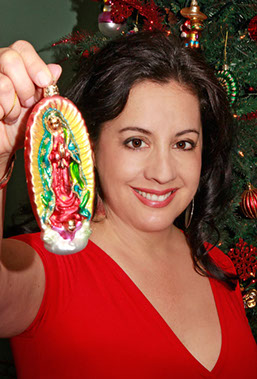

Hark, Latino Christmas nerds, your wish is granted. California-based CasaQ has been making ornaments since 2005, when founder and owner Darlene Tenes began looking for Latino-themed decorations and couldn’t find them. “In 2007 I decided to design two hand-painted glass ornaments with a Latino flair and they sparked an immediate interest from the Latin Grammy Award producers who called and asked for them to be featured in their official celebrity gift baskets,” shares Tenes.
2005, when founder and owner Darlene Tenes began looking for Latino-themed decorations and couldn’t find them. “In 2007 I decided to design two hand-painted glass ornaments with a Latino flair and they sparked an immediate interest from the Latin Grammy Award producers who called and asked for them to be featured in their official celebrity gift baskets,” shares Tenes.
Now, the business includes a catalog of 21 ornaments, including her original pan dulce series, a Frida Kahlo, Rudolfo (the reindeer), Papi Claus, and her most controversial ornament to date, Milagros, featuring a pregnant Virgen Mary.
“I conduct focus groups on each new ornament and this one was so polarizing, people either loved it or hated it,” she says. “I decided to produce it, because the folks that loved it, really loved it.”
Just last year, her ornaments were shown on TLC’s Deck the Halls with Dr. Christmas. In this episode, Dr. Christmas, aka Bob Pranga, and his partner Debi Staron selected CasaQ ornaments to decorate the tree in Mario Lopez’s home per his request that they be culturally relevant.”When we saw CasaQ ornaments, we knew they would be a perfect fit for Mario Lopez’s family home,” said Bob Pranga at the time, “Each design created by Darlene Tenes celebrates the love and pride he [Lopez] has for his rich Mexican heritage.”
At one time, her ornaments were available at Macy’s, and while they aren’t currently, she hopes to reconnect with the department store. She has also used her experience with Macy’s to help other Latino-owned businesses access retail wholesalers by organizing the first Casa Azul showroom at the LA Mart Gift and Home Summer Market, held July 15—July 20, 2015. She plans to make Casa Azul an annual event. CasaQ products can also be purchased online at www.casaq.com.
As an advocate as well as entrepreneur, Tenes admits that she has observed the growing commercialization of Día de los Muertos but offers that Latinos, as well as non-Latinos, may be missing the true meaning of the celebration. “I first organized a Day of the Dead celebration in San Jose in 1989. It was much more based on the true meaning of Day of the Dead,” she says. “Everything has gotten so commercialized, we can’t blame it solely on non-Latinos. All around people are forgetting the whole purpose of the celebration, which is to celebrate our ancestors. Dressing up alone forgets the significance of the celebration.”
Emilio Zamora, historian and associate professor at The University of Texas School of Information, agrees but adds that Latinos should use the celebration to affect change, recognizing great leaders as well as family. According to Zamora, the modern Día de los Muertos celebrations “lack a forward vision that acknowledges those that have come before have done all they could to speak on our behalf and advance our interests. We need to assume our own responsibility to redefine our cultural identity with reciprocity, mutuality, respect and understanding to advance our interests as a people.”
Last year, blogger Aya De Leon protested “colonizing the Day of the Dead” and received more than 1400 comments to date, many of them accusing her of racism. “Like the Pilgrims, you have begun to take over, to gentrify and colonize this holiday for yourselves,” she wrote. “I was shocked this year to find Day of the Dead events in my native Oakland Bay Area not only that were not organized by Chicanos or Mexicanos or Latinos, but events with zero Latino artists participating, involved, consulted, paid, recognized, acknowledged, prayed with.”
Still, Tenes adds that the mixing of cultures is natural and that it can be the catalyst for conversation and discovery. “That’s what I like,” she says, “teaching people about our culture, its beautiful traditions and customs, and our responsibility to do this with our children.”